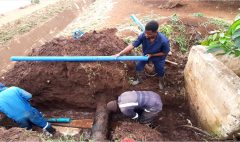Powering Data Online
October 31, 2022 2022-10-31 8:54<strong>Powering Data Online </strong><strong></strong>
Powering Data Online
In the energy sector, it’s essential to maintain a precise asset inventory that includes accurately mapped electric utility assets such as poles, transformers, cable lines, and substations. GIS makes it more simpler to handle asset data and gives you access to infrastructure insight. With this technology, members of the Energy Sector GIS Working Group in Uganda now have the perfect collaboration and geographic data sharing platform. Staff members can now readily access their own data across the organization and access data from other constituent organizations which form the group. What’s more, members of the public too can readily access basic GIS datasets that the group has published.
The Challenge
The Energy Sector GIS Working Group in Uganda brings together GIS professionals working in the energy sector in Uganda with membership drawn from the Ministry of Energy & Mineral Development, Renewable Energy Association, Uganda Electricity Transmission Company, UMEME, Uganda Electricity Generation Company, Electricity Regulatory Authority, and the German International Development Agency. Prior to the formation of the group, each of these organizations managed its own GIS datasets separately.
However, the separate management of data led to a series of challenges which included:
- Difficulties in data sharing arising from incompatibility occasioned by dissimilar formats and coordinate systems.
- Limited collaboration in projects because of difficulties in data sharing.
- Low accessibility and discoverability of basic but useful GIS datasets by the public.
- Duplication of effort in data collection.

How did GIS help?
Members of the group used Esri technology to create an ArcGIS Online organizational account where geographic data from respective organizations is standardized, organized, and curated and made accessible to users in the organizations and the public. “Setting up ArcGIS Online for the group was easy. Setting up user accounts and generating the first web map took less than a day and proficiency scaled up with time. “Said Martin Kretschmer, a member of the group. They set up an Open Data site on ArcGIS Online through which they easily share their GIS data with the public. Furthermore, they adopted the ready-to-use ArcGIS Online Apps, namely Operations Dashboard App to monitor, track and report real-time data feeds of field activities and Collector for ArcGIS App to collect and update data in the field.

Why use ArcGIS Online?
ArcGIS Online is a collaborative web GIS engineered as a system for your entire organization. It allows you to collaborate with others in your organization, quickly create interactive maps and other geographic content then publish and share them in Esri’s secure cloud. It comes with ready to use Apps and content.
Here is why ArcGIS Online is important:
- Collaboration made easy: Members of the working group set up private and public groups enabling interaction with their organizational data and sharing standardized content related to common activities. This helped them control access and increasingly gain common operating picture on projects and events.
- Supporting business functions: In UMEME for instance, GIS data is used in many of the core business functions such as customer service, billing, network planning, monitoring, and reporting. ArcGIS Online has enabled them to easily create and share maps throughout the organization supporting multiple functions.
- Significant time savings: Geographic data and map users cross the groups organizations are no longer tied up with the time-consuming tasks of searching and cleaning up data because key data sets that are often used are being made available on ArcGIS Online where they can be easily discovered.
- Decision support: Investors, government, and other agencies interested in the energy sector in Uganda are using GIS data made available through the open data site to plan new projects, develop feasibility studies, and monitor investments.
- Maximizing field workforce efficiency: Collector for ArcGIS and Operations Dashboard Apps are enabling organizations in the working group to improve coordination between field and office, improving management and productivity of their field crews.
Learn more about how GIS is helping in promoting sustainable agriculture and sustainable infrastructure







